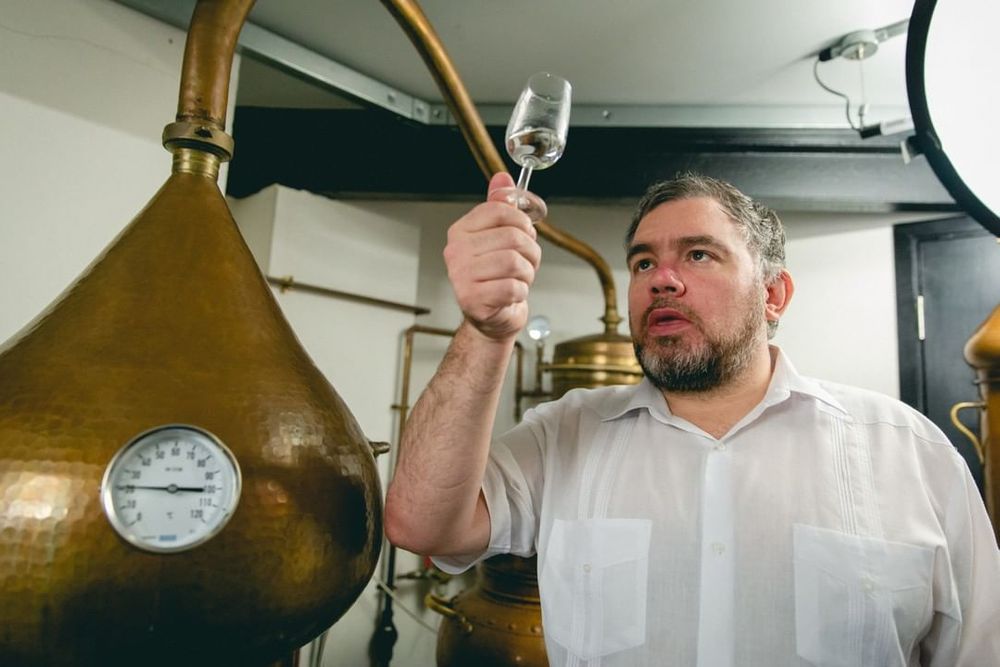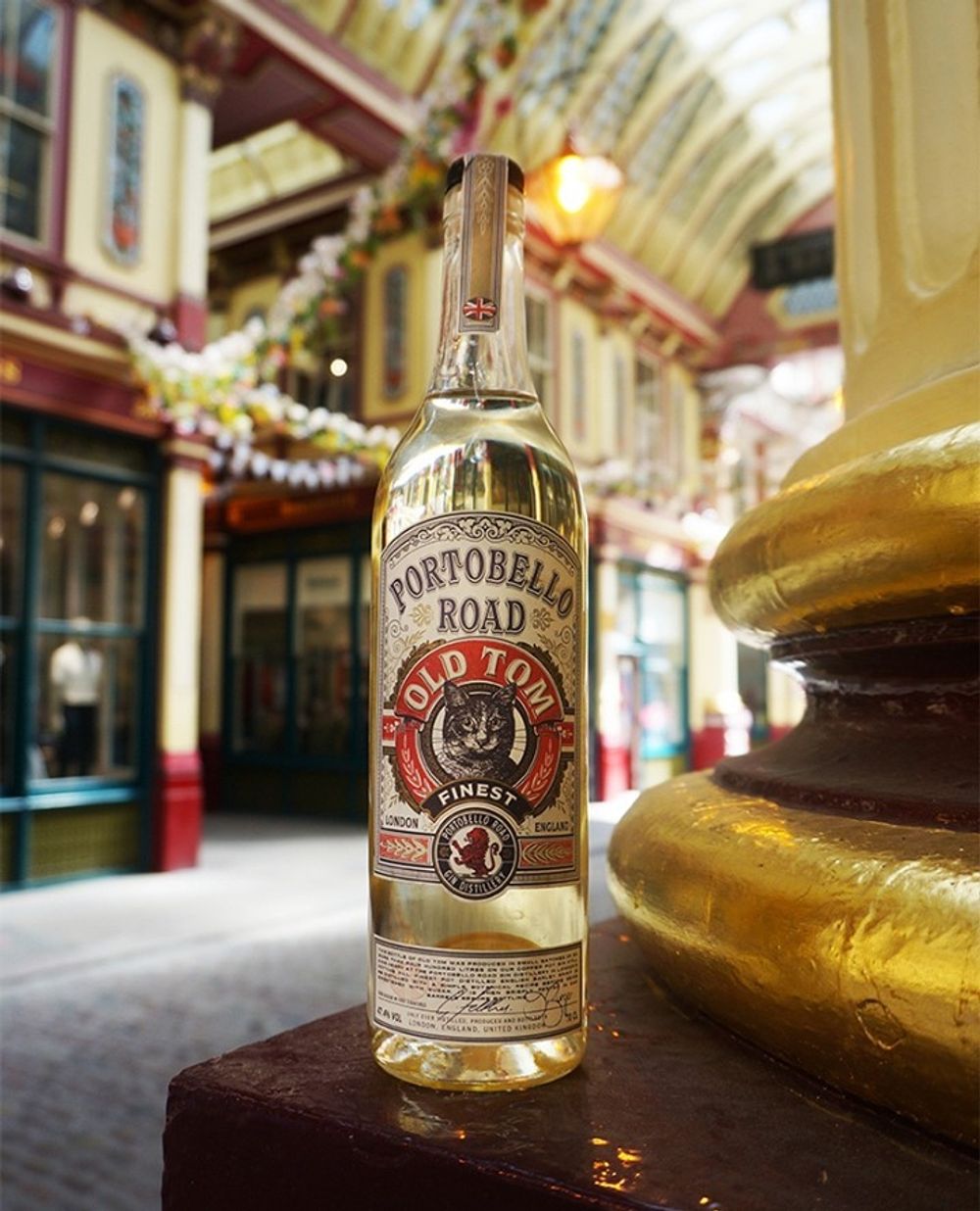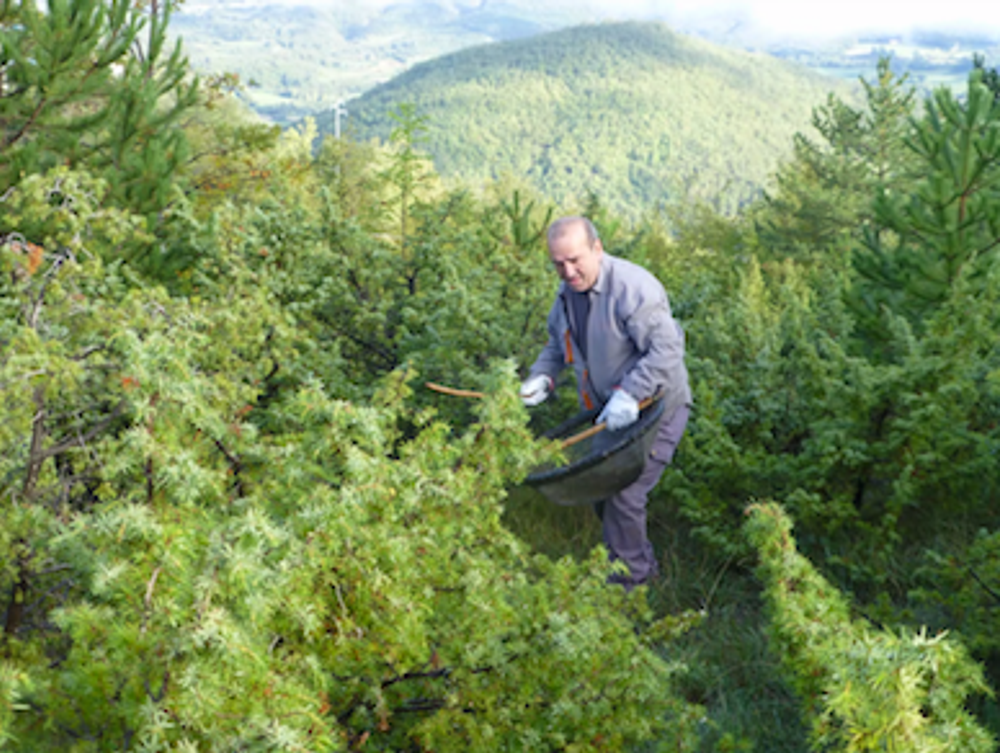“We took a batch of the regular Portobello Road London Dry Gin, put it back into one of our very small 30 litre copper stills and we added a few blocks of English butter,” says Burger about his ‘Butter Gin’.
Listening to co-founder Jake F Burger talk about gin is like taking a step back in time. At the Portobello Road Gin distillery’s virtual tasting, he was an encyclopaedia of knowledge for gin beginners such as myself who are used to the occasional supermarket staple like Gordon’s Pink, Beefeater London Dry, or the Lychee and Elderflower Drury 173. Luckily for me, the evening was just as enlightening and educational as it was a showcase of eye-popping gins.
Despite gin seeming to be a distinctly British drink, Burger corrects us by saying that “distilled Juniper beverages” were “an idea that we copied and stole from the low countries – Belgium and the Netherlands,” in the 1600s.

Jake F Burger
Gin-making in the UK has certainly come a long way from the strange concoction it was in its early days. “We’ve got one recipe from 1740 which calls for (instead of juniper berries and citrus peels), sulphuric acid, oil of almonds, oil of turpentine, lamp sugar, lime water, alum, carboxylic acid – all to be mixed with water and no natural botanicals at all.” It’s definitely not my cup of tea, but it’s good then that we’re in 2021 and not 1740. As Burger says, after these pioneering ‘gentlemen distillers’, the more professional producers of gin came onto the scene in the late 1700s and gin turned into a higher quality and more popular drink in the UK.
From the first few minutes of the tasting, it was clear to see that Portobello Road Gin have some real nerds in the company when it comes to gin history, and that history is kept alive in the four gins we tasted, which all attempt to recreate and rework some of the older British gins.
Recreating the Old Tom
The classic Old Tom Gin owes a debt to Fred Hodge and his Hodges gin distillery in Lambeth around the 1770s – the use of sugar compensating for its rudimentary distillation. The Portobello Road Old Tom is an attempt to recreate what the team thinks the original Hodges’ Old Tom would have been like.
“We found a marvellous book which was basically an instructional manual telling unscrupulous people how to create fake versions of the popular products of the day,” says Burger, “From this recipe we can learn that Hodges’ probably contained Italian juniper berries, German juniper berries, coriander seeds, Angelica root, Cassia bark, and Calamus Aromatics or, if that could not be obtained, Orris root.” Almost by chance, Portobello Road Gin found it was already making use of five of those ingredients in its own spirit.
The Portobello team also tried to recreate the yellowish tinge to the drink which they found in an 1859 description of the making of the gin. “It describes how beside the stills there were 60 immense wooden tanks where the gin was pumped, or where it would rest,” says Burger. “So, it would have sat in wood for a little while, and whenever you put a spirit on wood it absorbs some colour.”

The result of their endeavours is a gin which is distinctively sweet and viscous on the palate with a light spicy finish, making it more like a very light whisky than anything else. Out of all four gins, for Burger the Old Tom is perfect to drink neat. “We don’t really think of gin as a sipping spirit… But certainly the Old Tom is one which I think is at its best just as a sipping spirit.”
The London Dry Gin – where the story started
Next on the menu was Portobello’s classic London Dry, which won them first place in the 2018 Bartender Brand awards. Burger described the gin as “by bartenders and for bartenders” and “the gin that started Portobello Road’s story.”
London Dry Gin is a style that is normally distilled from a grain, although sometimes it can be from “apples, potatoes or sugar beets or even dairy whey” says Burger. Its provenance can be just as varied and is not tied to being made in London, more it’s dictated by “a particular set of regulations.” For Portobello Road Gin, its base spirit is distilled from English wheat mostly in Yorkshire and goes through a fermentation and distillation process in Lancashire. During this process any flavour is removed, and the gin becomes 96% alcohol and 4% water, which Burger says allows for a “canvas upon which we can paint.”
According to Burger, 99% of companies still buy their gin from a third party, and Portobello Road is one of those.
“One reason is that producing a spirit of that purity is not easy. It requires a lot of equipment, a lot of space, something which we don’t have at Portobello Road.” He also noted the environmental concern, “By using this centralised kind of production for our neutral grain spirit can really decrease our environmental impact. In fact, the producers of our grain spirit claim that they get 25% more alcohol per ton of grain than the industry standard. For us that means every bottle at Portobello has a drastically lower environmental impact, which of course is something that we all need to be concerned about in the modern era.”
Once produced, Portobello’s spirit is sent to London where part of it is made into smaller batch gins that guests can taste at the Ginstitute on Portobello Road, while the other part is sent to Charles Maxwell at the Thames Distillery in Clapham, London, which has been running for 340 years.

Juniper does not take to cultivation so that all of the world’s supply still comes from hand-harvested wild bushes.
After some purified water is added to the spirit, Portobello adds its nine botanicals, submerging them in the alcohol for about 24 hours. The first seven classic botanicals that make up most gins, and which are also used for Portobello’s London Dry, are: Italian juniper from Tuscany, which makes over half the amount of all the botanicals used, then coriander seed either from Ukraine or Bulgaria, the root of an Angelica plant, Iris roots, liquorice root, Spanish orange peels, and Egyptian lemon peels. It is arguably the addition of two other botanicals however which make Portobello’s London Dry Gin so unique.
“We wanted to have a bit more depth, complexity and character,” says Burger. “We also added Cassiopeia, which is kind of a relative of cinnamon. Imagine cinnamon turned all the way to 11. We also use nutmeg which makes up just 1% of all the botanicals that we use but it has the kind of spiciness, a pepperiness, a lingering kind of heat.”
Celebrated Butter Gin – the crème de la crème
It may sound a bit odd initially, but you won’t believe how good this is until you try it. Close your eyes as you sip, and you’ll think there’s a tiny scrumptious slab of butter melting across your tongue. On the nose, the gin is a bit like a lighter version of the London Dry, but the taste of coriander and juniper notes are completely toned down due to the sweet buttery taste that lingers on the tongue.
Strangely enough, original butter gins did not actually feature butter in their ingredients list. Having butter in the name was just a signal for a top-tier gin says Burger, “It had a similar meaning to cream, so when we talk about the cream of the crop, or the crème de la crème, it doesn’t mean it has cream in it! It just means it’s very good.”
Portobello, however, took the idea of “Butter Gin” quite literally by adding butter during the distillation process. “We took a batch of the regular Portobello Road London Dry Gin, put it back into one of our very small 30 litre copper stills and we added a few blocks of English butter. We distilled again and what came out was delicious.” You won’t believe it until you drink it.

Jake F Burger, Zoom tasting, April 2021
Sloeberry and Blackcurrant – not just for Christmas
Last but not least, was the sweetest of all four samples on offer – The Sloeberry and Blackcurrant Gin. This was the company’s sixth expression and was originally made as a Christmas special, which explains the warming, lingering finish. Burger says: “the finish kind of reminds me of childhood cough medicine.” It’s easy to see what he means. Drinking it neat feels like a warm comforting hug around your throat. Yet, it still manages to be light on the palate and doesn’t have the same viscosity as the Old Tom (or cough syrup).
Burger says that, even though it was a festive special, there’s no reason why the gin can’t be a success in the summer. “Mixed into a spritz or just with the Fever Tree blood orange soda it’s such a refreshing light spring/summer drink that I think it can bring sloe gin into the warmer months” says Burger. Even though it’s a fairly full of sweet almond and berry notes, there’s a sharp tangy finish, which also makes it light and fresh, and perfect for a sit in the sunshine.
According to Burger, “making sloe gin in England is a bit like making pasta sauce with the Italians, you can’t probably get it right, so we thought about how we might create something which is slightly different.” To do this, they tried to turn up the notch on some of traditional sloe gin’s qualities. “We use a nice full strength [of the spirit], and we use a lot of it to make sure the gin flavours are there.” They also use French sloe berries along with a small amount of Italian cherry liquor and French crème de cassis, which Burger says gives their sloe gin its unique quality.
Thinking pink?
The Sloe and Blackcurrant is good to try if you’re a fan of ‘pink gin’ says Burger, which saw a huge surge in popularity over the past few years. However, when questioned on whether we’ll be seeing a Portobello pink anytime soon, the answer was no. With the distillery’s clear interest in the history of gin, its preference is to keep its focus on reinventing classics rather than strictly following the consumer trends. “We did do a pink – a rhubarb one. For me, I was tasting a lot that was out there, but it wasn’t tasty enough. We decided it wasn’t for Portobello.”

The future of the canned cocktail
An exciting part of the tasting was the canned cocktail versions of the spirits included in the samples box. For now, Burger can’t confirm when they might be on the market, but it is an idea they’re looking into. “We just bought a canning machine for the purpose of being able to send out samples for events like this. We would like to expand our offering in that respect, there’s nothing I can announce or confirm just yet, but we’ve certainly got some more in the pipeline.”
With the session only lasting 60 minutes, it was impossible to get through everything without getting a bit too giddy for a Tuesday evening, so I’m grateful to still have the Old Tom and Sloeberry and Blackcurrant cocktails to crack open once warmer days arrive.
Portobello Road Gin is now reopened to the public. You’ll also have the opportunity to learn more about the A-Z of gin in their Experience sessions inside the distillery from May 17. Have a peak here.










































